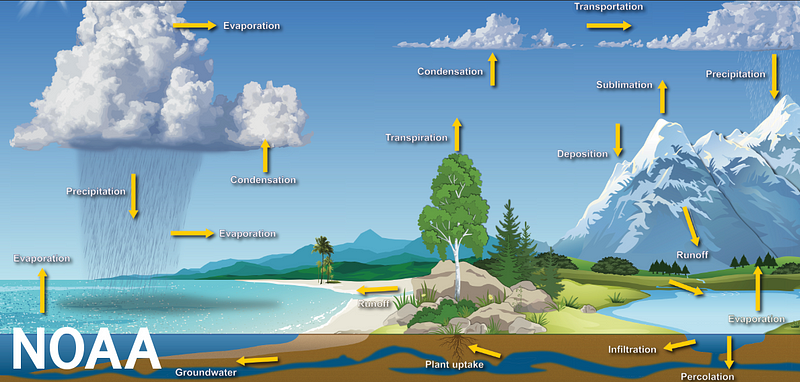Gaia Hypothesis: Is Our Planet a Living Conscious Entity?
Written on
Chapter 1: Understanding Gaia
The Earth is an extraordinary and intricate system that supports diverse forms of life. From towering mountain ranges to the ocean's profound depths, life has adapted and flourished across our planet. This complex interplay of biodiversity raises an intriguing question: could Earth itself be regarded as a living entity? The Gaia Hypothesis, proposed by expert Earth scientists, suggests that the planet is not merely a collection of lifeless materials, but rather a conscious, living organism, akin to the biomes existing within our own bodies.
Ancient Perspectives
Throughout history, various ancient cultures have hinted at concepts similar to the Gaia Hypothesis. The Greeks viewed Gaia as the embodiment of Earth, honoring her as the primordial mother of all creation. Similarly, Native American tribes like the Hopi, Iroquois, and Navajo referred to Earth as Mother or Mother Earth. The Egyptians worshipped Geb, a male deity depicted as lying on the ground, who upheld the cosmic order. Hindu traditions recognized Prithvi, while the Chinese revered Tian, and indigenous Australians also embraced the idea of Earth possessing its own consciousness.
These examples illustrate that many civilizations have regarded the Earth as a living being. Such beliefs often influenced their spiritual practices, environmental ethics, and cultural rituals, reinforcing the idea that Earth deserves the same respect as any other living entity.
Modern Interpretations of Gaia
In the 1960s, British scientist James Lovelock challenged the conventional notion of Earth as a mere rock drifting through space. His insights were sparked by his work with NASA on planetary exploration, where he created instruments designed to detect signs of life on Mars. Lovelock explored the scientific underpinnings of the Gaia Hypothesis, proposing that Earth's various components—its atmosphere, oceans, and living organisms—interact in a manner reminiscent of the systems within our own bodies. He posited that these systems self-regulate and self-maintain, creating optimal conditions for life to thrive.
Homeostasis and Environmental Balance
While this balance exists in harmony, it is delicate; any disturbance could have dire repercussions for the continuity of life. Homeostasis refers to an organism's capacity to regulate internal conditions to ensure stability and functionality. According to the Gaia Hypothesis, Earth displays a form of global homeostasis. Just as our bodies maintain temperature and pH levels to support life, Earth preserves conditions favorable for life to prosper.
For instance, Earth's temperature has remained relatively stable over billions of years, despite fluctuations in solar radiation. Although we have experienced ice ages and cooling periods, the overall temperature has largely remained consistent. Positioned within the Goldilocks zone, Earth maintains ideal conditions for liquid water to form, crucial for life. The Gaia Hypothesis posits that interactions between living organisms and their environment—including the regulation of greenhouse gases—are vital for sustaining this temperature stability.
Most carbon is absorbed by the oceans and utilized by marine life. In return, phytoplankton, which consume carbon, produce the oxygen we breathe. The water cycle facilitates the evaporation of ocean water, forming clouds that precipitate rain, nourishing plant life that in turn captures carbon from the atmosphere, enriching our air with more breathable oxygen.

The Earth's Biosphere and Our Gut Microbiome
There are striking similarities between Earth’s biosphere and our gut microbiomes. The Earth’s biosphere, encompassing the atmosphere and the planet's surface, functions similarly to our gut microbiome, where trillions of microorganisms collaborate to influence digestion, immunity, and overall health. Likewise, the diverse species within the biosphere interact to preserve planetary health. Consider scavengers like vultures, crows, and jackals, which play roles akin to bacteria within nature's digestive processes.
Our bodies host numerous microenvironments, each with distinct microbial communities that serve unique functions. For example, our skin, mouth, gut, and respiratory system each harbor microorganisms critical for our health. Just as these bodily systems are essential for our well-being, Earth's ecosystems—ranging from rainforests to coral reefs—are integral to maintaining ecological balance.
Moreover, just as our lifestyle choices can affect the composition of our gut microbiome, human activities significantly impact Earth's Gaia system. Industrialization, deforestation, pollution, and greenhouse gas emissions can disrupt the planet’s self-regulating mechanisms, threatening the delicate balance that has supported life for millions, if not billions, of years. Think of industrialization as a global form of unhealthy eating: the inputs dictate overall health, just as our actions towards the planet influence its well-being.
The Gaia hypothesis, whether wholly accurate or not, urges us to perceive Earth not merely as a backdrop to human existence but as a living, conscious entity that sustains life through complex self-regulating systems. Drawing parallels between Earth’s biosphere and our own microbiomes offers a renewed perspective on our interconnectedness with nature.
As we strive to maintain the health of our bodies by nurturing our microbiomes, we must also acknowledge our responsibility to protect Earth’s ecosystems. The choices we make as individuals and as a society carry weight, affecting both the planet and our survival. Embracing a holistic viewpoint that recognizes the interconnection of all life on Earth—from the tiniest microorganisms within us to the vast ecosystems enveloping our planet—reminds us that we are not separate from nature but rather an integral part of it. Our future relies on how well we understand and respect this relationship.
Chapter 2: Gaia Hypothesis in Action
The first video titled "Gaia Hypothesis - James Lovelock - YouTube" explores the foundational concepts behind Lovelock's theory, detailing how life and the environment interact.
The second video, "James Lovelock Explains Gaia Hypothesis on The Sacred Balance (TV) - YouTube," features Lovelock discussing the implications of his hypothesis on our understanding of life on Earth.